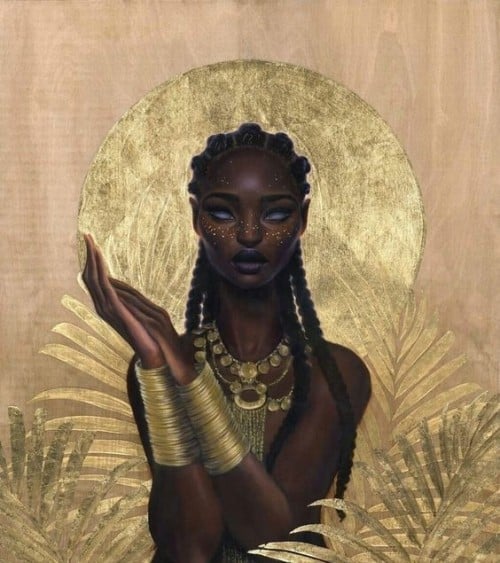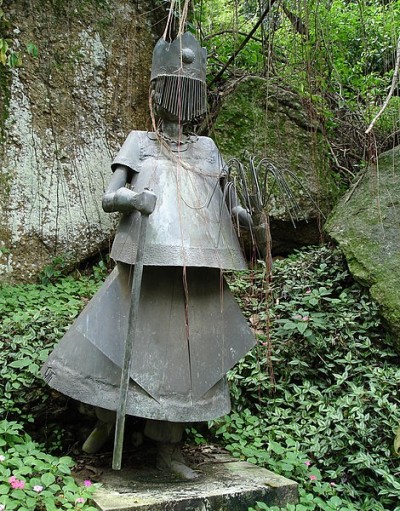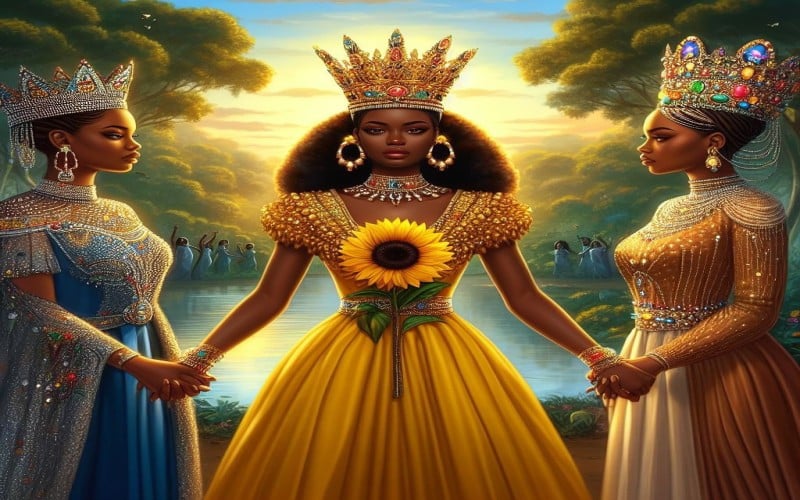Orisha Ọya is a powerful deity from the Yoruba religion. People know her as the queen of the seas. She is a divine force that rules over the natural world. Ọya brings balance and harmony to all living things. The rhythms of the ocean, the cycles of life, and the mysteries of the universe feel her presence.
In African mythology, people respect Ọya as a symbol of strength, wisdom, and protection. She is often portrayed as a fierce and royal figure. She wears a crown of sea shells and carries a staff with the power of the ocean. Those seeking guidance and direction seek after her wisdom. All who encounter her admire her grace.
Names and Etymology of Ọya
The name O Ya in Yoruba comes from the words O Ya, which means ‘she tore’.
Pronouncing Ọya
Pronounce O as O in Origin.
Pronounce Ya as Ya in Yacht.
Names of Ọya
Ọya is often called many names in Yoruba mythology which include:
- Iyasan (mother of nine).
- Ọya ajere (carrier of the container of fire).
- Ayi lo da (Queen of death).
Mythology of the Yoruba deity, Ọya.
Several myths exist concerning the mythology of the Yoruba deity, Ọya.

Ọya, Patron of Death
There is a myth that Ọya is the keeper of the newly dead. She helps them make a successful transition to the next world.
She could call on death when necessary, or hold death back. This earned her the name The Queen of the Cemetery.
Mortal Ọya
Another Yoruba myth believed that she was once a mortal woman. She was in a relationship with Shango, the Orisha of thunder and lightning. The two were lovers and often worked together to create storms.
In some stories, her jealousy led to her causing storms. The storms threatened to overpower Shango, eventually leading to their separation.
Ọya and Shango
Ọya’s story is never complete without Shango.
Some scholars believe that she, alongside Obá and Osun, was Shango’s (god of thunder) wife. They also concluded that, during fights and wars, Shango would send his wife ahead to fight with the wind. It is important to note that without her, Sango would barely accomplish anything. Many Santeros (priests of Santeria) believe Sango got his power from her. It is agreeable that she gives expression to his voice as thunder.
Ọya, Daughter of Yemoja
According to Yoruba mythology Ọya is the sister of Ayao and daughter of Yemoja. Yemoja is a powerful and benevolent deity. She is often associated with fertility, prosperity, and protection. According to this myth, she was born from the tears of Yemoja, who was grieving the loss of her husband and children.
According to this myth, the goddess was born with the power to control the forces of nature. This included the wind, the waves, and the tides. She is also believed to have the ability to heal the sick. She can protect the vulnerable and bring good fortune to those who call upon her.
Ọya’s Power

Psychic abilities: People believe Ọya can read auras and see into the future. This allows her to provide a glimpse into one’s destiny. She helps individuals prepare for challenges ahead.
Rebirth and transformation: She is also known for her power to ease rebirth and transformation. People believe that Ọya can help individuals overcome challenges and find new ways of seeing the world. She often sees herself as a patroness of women. She associates this power with providing support and guidance throughout the stages of a woman’s life. This includes birth, death, and rebirth.
Shape Shifting: Ọya is good at disguises. She can transform into different animals like buffalo and antelope.
Significance of Ọya
Some common significance associated with Ọya include:
1. Ọya is often portrayed as a powerful and protective deity. She is responsible for the safety and well-being of her people. People believe that she has the ability to ward off evil spirits and negative energies. They also believe she brings good fortune and prosperity to those who call upon her.
2. In some cultures, people associate Ọya with fertility and prosperity. They believe that she brings these blessings to those who honor her. Women often invoke her during pregnancy and childbirth. She is also associated with the harvest and the cycle of life.
3. Ọya embodies attributes such as strength and courage. She is often portrayed as a fearless and powerful warrior. People believe that she has the ability to protect them from harm and bring victory to those who fight in her name.
4. In some cultures, people associate Ọya with wisdom and knowledge. They believe she possesses great insight and understanding. People often seek her advice and guidance. She distinguishes herself as a teacher and mentor.
5. Many people believe that she connects to the natural world. They think she understands the cycles of nature. They believe she comprehends the interconnectedness of all living things.
She is often invoked by those who wish to connect with the natural world and to live in harmony with the earth.
Characteristics of Ọya
- Bring changes: In many African cultures, people believe that Ọya has the power to bring about changes in the world. These changes can either be positive or negative. She also has the ability to shape and mold the natural world.
- Compassion: Ọya’s role as a warrior and protector often brings compassion to those who are in need.
- Divine Energy: People believe that Ọya is the ruler of the wind and storms. They think she controls the flow of divine energy throughout the physical world.
- Guidance: Ọya is often invoked by leaders and elders to guide and protect them.
- Protects the Vulnerable: Ọya is a strong protector of women. She earns recognition for protecting the vulnerable. She is often evoked by women to protect them from sexual assault or any form of gender-based violence.
- Healing: People believe that Ọya has the power to heal physical and emotional ailments.
- Good Fortune: Ọya’s devotees believe that she brings good fortune.
Symbols associated with Ọya

The orishas’ symbols include objects like swords, shields, and cowry shells. They also include animals like water buffalo and colors like red.
Objects
Sword and shield: This signifies Ọya being protective and also shows she is a warrior.
Cowry shells: The goddess is usually adorned with cowries which signifies wealth and prosperity.
Animals
Water Buffalo: At times, Ọya transforms into a water buffalo.
Color
Red: Ọya is mostly portrayed wearing red garments. Red signifies blood and passion as well as fire.
Worship and offerings
People pray to Ọya daily. They make traditional offerings of both Akara and Acaraje (bean cake) to the goddess.
People peel or crush beans to make Akara or Acaraje. Then, they shaped the mixture into balls and fried them in palm oil (dende). A simpler, unseasoned form of it was often used in rituals. They made the goddess special akara, which is also a common street food.
Her offerings can also include nonfood items like coins.
Ọya Grove
She became a deity in irafere. Ira town, located in Kwara state Nigeria, still exists today. Ọya Grove, located in Ira, answers every prayer to the goddess.
There is a statue of the goddess and her nine children. There is also a statue of the buffalo she disguised as. Another statue shows an antelope, and another is the arugba Ọya, the carrier of Ọya’s calabash.
Religious Festival
The Ọya festival was originally held twice a year. A group of people came together and wanted to stop the tradition from becoming extinct. This made them celebrate it every year. This date differs from the traditionalists’ date, which made it twice a year.
People come to pray and ask for whatever they need from the goddess. This could be prosperity, children, or support. They vow to give back to her if their prayers are answered.
Taboos of Ọya
Objects
- Palm Kernel Oil.
- Pork.
- Pumpkin.
Animals
- Ram.
- Mutton.
- Okere(Squirrel).
- Aja(Dog).
- Male or female sheep.
across Borders
Ọya and many other divinities have greatly influenced the trans-border trade between Nigeria and Benin. The local communities in this regioa worship these divinities.
She is a powerful figure in African religions and spiritual traditions. Her influence transcends cultural boundaries. Various African spiritual traditions such as Santeria, Candomble, and Vodou honor her.
Santeria
Oya is a powerful and distinguished goddess in Santeria. Santeria is a syncretic religion that combines elements of Yoruba religion with Catholicism.
She appears as a powerful and wise woman, with associations to the ocean and the sea. People believe that she has the power to control the tides, summon storms, and bring forth the rain. Women often invoke her during pregnancy and childbirth.
People in Santeria believe that Ọya is a benevolent deity. She brings blessings and wealth to those who worship her. She is also believed to be a fierce protector, who will defend her disciples from hurt and danger.
People often worship her by performing rituals and ceremonies. They use sacred objects and symbols. People designed these rituals and ceremonies to appease the goddess. They also seek her blessings and protection.
Candomble
In Candomblé, people consider Ọya as a powerful and wise deity, who associates with the ocean and the sea. People believe she has the power to control the tides and summon storms as well as bring the rain.
She dresses in white and adorns herself with gold and silver jewelry. People believe she is a benevolent deity. She brings blessings and prosperity to those who worship her.
Ọya is often invoked by women during pregnancy and childbirth. They believe she is a powerful protector and healer. Women may perform rituals and ceremonies to honor her. They seek her blessings and protection during these times.
In Candomblé, people also associate Ọya with the concept of “orixás.” They believe these are spiritual entities. They inhabit the world with their own personalities and characteristics.
Final thoughts
- Orisha Ọya is a powerful deity from the Yoruba religion, known as ruler of the natural world.
- In African mythology, people hold Ọya in awe as a symbol of strength, wisdom, and protection.
- People believe that Ọya has psychic abilities. They also believe she has divination powers. They think she can help with rebirth and transformation.
- She associates herself with power and protection. She also represents fertility, prosperity, strength, courage, wisdom, and a deep connection to nature.
- Her symbols include a sword, shield, cowries, water buffalo, and the color red.
- Various African spiritual traditions honor Ọya. These include Santeria, Candomble, and Vodou.
Featured Image Credit: oshunviolin via Instagram

